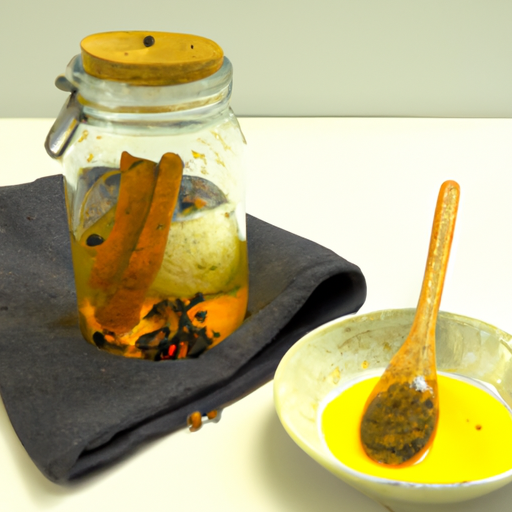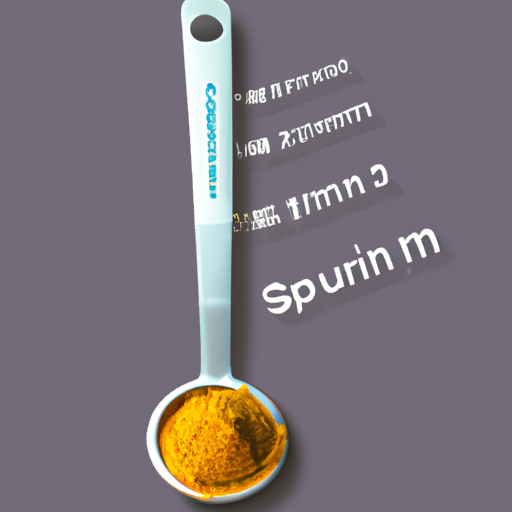I have always had a fascination with natural remedies that can enhance my well-being. When I was introduced to the numerous advantages of turmeric tea, I was captivated. Turmeric is known for its anti-inflammatory properties, strong antioxidant effects, and potential to enhance cognitive function. Additionally, it is simple to prepare at home using turmeric powder.
If you’re looking for a healthy and delicious way to incorporate more turmeric into your diet, making turmeric tea is a great option. Not only is it simple to prepare, but it’s also a tasty way to reap the many benefits of this powerful spice.
In this article, I’ll walk you through everything you need to know about making turmeric tea from turmeric powder – from its health benefits and ingredients needed to step-by-step instructions on how to make it at home.
Key Takeaways
- Turmeric tea has anti-inflammatory and antioxidant properties, aids digestion and can boost brain function.
- To make turmeric tea, boil 2 cups of water and add 1 teaspoon of high-quality organic turmeric powder, let simmer for 10 minutes, strain and sweeten if desired.
- Milk or cream can help the body absorb curcumin, the active ingredient in turmeric.
- Consult a doctor before consuming turmeric tea if you have any medical conditions or are taking medications.
Health Benefits of Turmeric Tea
You’ll be amazed at the incredible health benefits you’ll get from sipping on a warm cup of turmeric tea made from that powder in your pantry. Turmeric has been used for centuries in Ayurvedic and Chinese medicine to treat various ailments, and it’s now gaining popularity in Western cultures as well.
One of the main benefits of turmeric tea is its ability to reduce inflammation in the body, thanks to its active ingredient, curcumin. Chronic inflammation is believed to contribute to many diseases, including heart disease, cancer, and Alzheimer’s.
Another benefit of turmeric tea is its ability to aid digestion. Drinking a cup of turmeric tea after a meal can help stimulate bile production, which helps break down fats and aids in digestion. It also has anti-inflammatory effects on the digestive system itself, making it helpful for those with conditions such as irritable bowel syndrome (IBS) or ulcerative colitis.
So not only does turmeric add flavor and color to your tea, but it can also have significant health benefits as well.
Now let’s move on to the ingredients needed to make this delicious and nutritious drink.
Ingredients Needed to Make Turmeric Tea
To concoct this cozy cup, collect the crucial components like turmeric powder, ginger, coconut milk, cinnamon sticks, and honey. These ingredients not only taste great but also have numerous health benefits.
Turmeric tea is rich in antioxidants and anti-inflammatory properties that can help reduce inflammation in the body, improve brain function, and lower the risk of chronic diseases.
There are many best turmeric tea recipes available online that you can try at home. Some people prefer adding black pepper to increase its absorption rate, while others add lemon juice for a tangy taste. Whatever recipe you choose to follow, make sure to use high-quality organic turmeric powder and other ingredients for maximum health benefits.
Now that we have our ingredients ready, let’s move on to the next section where we’ll learn how to make turmeric tea step-by-step.
Step-by-Step Guide to Making Turmeric Tea
Now let’s get started on brewing a warm and healthy cup of this golden elixir with just a few simple steps.
First, boil 2 cups of water in a small saucepan. Once the water reaches boiling point, add 1 teaspoon of turmeric powder to the pan. Let the mixture simmer for about 10 minutes while stirring occasionally.
After 10 minutes, turn off the heat and strain the tea into your favorite mug using a fine mesh strainer. You can sweeten your tea with honey or any other natural sweetener if desired.
For variations in flavor, you can add ginger or cinnamon powder while brewing to enhance its taste profile. Experimenting with different brewing techniques like steeping for longer periods can also provide different results.
To adjust the recipe to your taste preferences, try adding more or less turmeric powder depending on how strong you want it to be. You can also experiment with different types of milk like almond or coconut milk instead of water for a creamier texture.
With these tips in mind, enjoy your homemade turmeric tea that’s not only delicious but also packed with health benefits!
Tips for Adjusting the Recipe to Your Taste Preferences
When it comes to making turmeric tea, I’ve learned a few tips that can help you adjust the recipe to your taste preferences.
One easy adjustment is adding sweeteners like honey or maple syrup to balance out the strong flavor of turmeric.
Another option is adding milk or cream for a creamier texture and added health benefits.
Lastly, deciding whether to serve your turmeric tea hot or iced can also make a big difference in how you enjoy this healthy beverage.
Adding Sweeteners
Although some people prefer their turmeric tea without any added sweeteners, a touch of honey or maple syrup can complement the earthy flavor and provide a natural sweetness. However, it’s important to choose sweetener alternatives that are healthy and won’t spike your blood sugar levels. Here are some natural sweeteners you can add to your cup of turmeric tea:
| Sweetener | Description |
|---|---|
| Honey | A natural sweetener with anti-inflammatory properties. Choose raw honey for maximum health benefits. |
| Maple Syrup | Made from the sap of maple trees, this sweetener contains antioxidants and minerals like zinc and manganese. Choose 100% pure maple syrup over artificially flavored options. |
| Stevia | A zero-calorie sweetener derived from the stevia plant. It doesn’t raise blood sugar levels and has been shown to have anti-inflammatory effects. |
Adding a small amount of one of these natural sweeteners can enhance the flavor profile of your turmeric tea while also providing additional health benefits. Once you’ve added your desired amount of sweetener, stir well before enjoying your cozy cup of turmeric tea! In the next section, we’ll discuss how to further customize your drink by adding milk or cream.
Adding Milk or Cream
Adding a splash of milk or cream to your turmeric tea will create a smooth and velvety texture that’s sure to delight your taste buds. Not only does it enhance the flavor, but it also adds some health benefits.
The fat in milk helps the body absorb curcumin, which is the active compound in turmeric responsible for its anti-inflammatory properties. Additionally, adding milk can help ease digestion and soothe an upset stomach.
There are different types of cream you can use in your turmeric tea, depending on your preference and dietary restrictions. Whole dairy milk is the most common option, but if you want a dairy-free alternative, coconut cream or almond milk works well too.
For those who prefer a richer flavor, heavy cream or half-and-half can be used instead. Experiment with different types of cream to find what suits you best.
As you mix in your preferred type of cream into your turmeric tea, savor its smoothness and enjoy its additional health benefits.
Now that we’ve talked about adding milk or cream, let’s move onto how to serve this delicious beverage hot or iced!
Serving Hot or Iced
To enjoy your turmeric-infused beverage in any weather, simply switch up the temperature and add some ice or heat! For a hot cup of turmeric tea, pour boiling water over your prepared mixture of turmeric powder, honey, and lemon. Stir well and let steep for 5-10 minutes before enjoying. The warmth of the drink can be especially comforting during colder months or when you need a little pick-me-up.
If you prefer something cooler, try serving your turmeric tea over ice. Simply prepare as instructed above and then let cool in the refrigerator for at least an hour. Pour over ice and enjoy! This is a great option for warmer days or when you want to cool down after a workout.
Regardless of whether you choose to serve it hot or iced, the best time to drink turmeric tea is in the morning or early afternoon as it can have energizing effects. And now that we know how to make it and serve it up just right, let’s talk about recommended dosage and frequency.
Recommended Dosage and Frequency
For a soothing cup of turmeric tea, you should aim for a dosage of 1-2 teaspoons of turmeric powder per cup of hot water and drink it regularly to reap its benefits. Here are some recommendations on how often to consume turmeric tea and what to keep in mind:
- Start with one cup per day and increase gradually.
- Consistency is key – try to drink it daily or at least a few times a week.
- It’s best consumed between meals, as adding milk or sugar may interfere with absorption.
- If you have any medical conditions or are taking medications, consult your doctor before consuming turmeric tea.
By following these guidelines, you can make the most out of drinking this delicious beverage. However, there are other ways to incorporate turmeric into your diet that can also be beneficial for your health.
Other Ways to Incorporate Turmeric into Your Diet
When it comes to incorporating turmeric into my diet, I like to explore different options. One way is to use turmeric in cooking, which not only adds flavor but also health benefits.
Another option is taking turmeric supplements for convenience and consistency.
Lastly, there are other delicious turmeric-based beverages out there that make a great addition to any meal or snack.
Cooking with Turmeric
Cooking with turmeric adds a vibrant yellow color and warm, earthy flavor to dishes. This spice is commonly used in Indian cuisine, but it can also be added to soups, stews, rice dishes, and even smoothies for a powerful nutritional boost.
In addition to its culinary uses, turmeric has been traditionally used in skincare for its anti-inflammatory properties. Here’s how you can incorporate turmeric into your cooking:
- Add a pinch of turmeric to scrambled eggs or tofu scramble for a colorful twist on breakfast.
- Use turmeric as a seasoning for roasted vegetables like cauliflower or sweet potatoes.
- Make a homemade curry by sautéing onions and garlic with turmeric powder before adding coconut milk and your favorite veggies or protein source.
- Mix turmeric into salad dressings or marinades for an added health boost.
Using turmeric supplements is another way to reap the benefits of this potent spice without incorporating it into your cooking.
Using Turmeric Supplements
After learning about cooking with turmeric, I wanted to explore other ways to incorporate this spice into my daily routine. That’s when I stumbled upon turmeric supplements.
These supplements are an easy way to consume the health benefits of turmeric without having to add it to every meal. Turmeric supplements come in various forms such as capsules, tablets, and powders.
When taking them, it’s essential to follow dosage recommendations on the label or suggested by a healthcare professional. It’s important not to exceed the recommended amount as high doses may lead to side effects such as upset stomach or diarrhea. However, when taken in moderation, these supplements can aid in reducing inflammation and boosting overall health.
Moving forward from using turmeric supplements, let me share with you some other delicious turmeric-based beverages that you can make at home!
Other Turmeric-Based Beverages
If you’re looking for a refreshing way to enjoy the benefits of this golden spice, try mixing turmeric with coconut milk and honey for a soothing and healthy drink.
Another way to incorporate turmeric into your beverages is by adding it to cocktails or smoothies. Turmeric-based cocktails have become increasingly popular in recent years due to their unique flavors and health benefits.
For those who prefer smoothies, turmeric can easily be added to any fruit or vegetable blend. Not only does it add a vibrant color, but it also provides anti-inflammatory properties that can help reduce inflammation in the body.
Whether you choose to mix turmeric with coconut milk or add it to your favorite smoothie recipe, there are plenty of delicious ways to incorporate this superfood into your daily routine.
To continue learning about the benefits of turmeric tea and how you can make your own from high-quality turmeric powder, let’s explore where you can purchase this ingredient.
Where to Buy High-Quality Turmeric Powder
To find high-quality turmeric powder, you should search for a reputable spice store or check online retailers that specialize in organic spices. Some of the best brands include Simply Organic, Frontier Co-op, and Starwest Botanicals. These brands pride themselves on sourcing their turmeric from sustainable farms that do not use harmful pesticides or chemicals.
When comparing prices, it’s important to note that higher quality turmeric may come at a slightly higher price point. However, investing in a good quality product can ensure that you are getting the full health benefits of this powerful spice. Once you have found your preferred brand of turmeric powder, it’s important to store it properly to ensure its longevity.
(Note: Next section will be about storing turmeric powder for longevity.)
Storing Turmeric Powder for Longevity
As someone who regularly uses turmeric powder in my cooking and for making tea, I know how important it is to store it properly. To maintain its quality and potency, it’s crucial to use the right storage containers.
Ideal storage conditions involve keeping the powder away from light, heat, and moisture. Understanding the shelf life of turmeric powder can help you determine when it’s time to replace old stock with fresh batches.
So, to ensure that your turmeric powder stays fresh for as long as possible, follow these guidelines: use proper storage containers, keep it away from light, heat, and moisture, and be aware of its shelf life.
Proper Storage Containers
When storing your turmeric powder, make sure to choose a tight-sealing container to keep out moisture and preserve its flavor. Proper storage containers can range from glass jars with rubber gaskets, to plastic containers with snap-on lids. It is best to avoid using open bags or containers that are not airtight as they can allow moisture in, causing the powder to clump and lose its potency.
To help you choose the right container for your turmeric powder, here are some examples of proper storage containers:
| Container Type | Pros | Cons |
|---|---|---|
| Glass Jar with Rubber Gasket | Airtight seal, easy to clean, protects against light exposure | Can break if dropped |
| Plastic Container with Snap-On Lid | Lightweight, durable, easy to find in stores | May not protect against light exposure as well as glass |
| Metal Tin with Screw-On Lid | Durable and compact for travel or on-the-go use | Can rust over time if not dried thoroughly after washing |
Choosing the right container will help extend the shelf life of your turmeric powder and maintain its quality. Now let’s move on to discussing ideal storage conditions.
Ideal Storage Conditions
Maintaining the quality of your turmeric powder requires storing it in specific conditions that preserve its flavor and potency. Proper storage can make a significant difference in the longevity and freshness of your turmeric powder. Here are some ideal storage conditions to help you preserve your turmeric powder:
- Store it in an airtight container to prevent moisture from entering.
- Keep it away from direct sunlight, heat, and humidity.
- Place the container in a cool, dark place like a pantry or cupboard.
By following these simple steps, you can ensure that your turmeric powder stays fresh for longer periods.
The next section will discuss the shelf life of turmeric powder and how long you can expect it to last before losing its potency.
Shelf Life of Turmeric Powder
To ensure that your turmeric spice remains fresh, it is important to know its shelf life. You might find yourself wondering if the turmeric powder you have been using for a while is still good enough to use in cooking or if it has lost its flavor and potency. Turmeric Powder Storage: Best Practices involve keeping the spice away from heat, light, moisture, and air exposure. It is best to store turmeric in an airtight container in a cool, dark place such as a pantry or cupboard.
Turmeric Powder: Preservation, Degradation Factors are important to consider when storing the spice long-term. Turmeric can last up to two years before losing its flavor and potency. However, factors such as heat and humidity can cause the spice to degrade faster. To ensure your turmeric powder stays fresh for longer, keep it stored properly and check on it regularly for any signs of degradation such as clumping or loss of aroma.
Frequently Asked Questions
Can I use fresh turmeric instead of turmeric powder to make turmeric tea?
Yes, you can use fresh turmeric to make fresh turmeric tea. It has a stronger flavor and more potent health benefits than turmeric powder. However, it may require more preparation time and may be harder to find in some areas compared to turmeric powder.
Is it safe to consume turmeric tea every day?
Consuming turmeric tea every day has many benefits, such as reducing inflammation and boosting immunity. However, excessive intake can lead to issues like stomach upset and gallbladder problems. It’s best to limit daily intake to 1-2 cups.
Can turmeric tea help with weight loss?
I’m pleased to report that Turmeric Tea is an excellent aid for weight loss. It helps boost metabolism and burn calories, making it a powerful tool in your health arsenal. Incorporating this tea into your daily routine can provide many benefits.
What are the potential side effects of consuming turmeric tea?
I’ll discuss potential risks and precautions of consuming turmeric tea. While it’s known for its immune support and anti-inflammatory properties, excessive consumption may cause stomach upset, dizziness or blood thinning. Consult your doctor before use.
Can I add other herbs or spices to my turmeric tea for added health benefits?
Spicing up turmeric tea with herbs like ginger, cinnamon or mint can add flavor and health benefits. Recipe variations abound, so experiment to find the herbal blend that’s right for you.
Conclusion
Wow, making turmeric tea from turmeric powder is so easy and the health benefits are amazing! It boosts your immunity, helps with inflammation and digestion, and is perfect for starting your day or as an afternoon pick-me-up.
I can’t stress enough how simple this recipe is – just a few ingredients and you’re good to go. You can easily adjust the recipe to fit your taste preferences. If you’re not a fan of drinking tea, there are plenty of other ways to incorporate turmeric into your diet for maximum health benefits.
So, what are you waiting for? Get yourself some high-quality turmeric powder and start reaping the amazing benefits of this superfood today! Your body will thank you.










